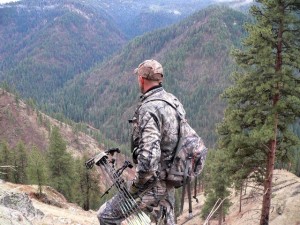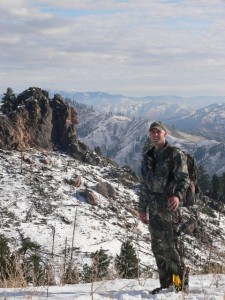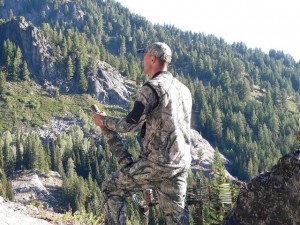Layering for Elk
 Let’s take a look at the importance of proper layering for chasing elk in the rugged mountains they call home.
Let’s take a look at the importance of proper layering for chasing elk in the rugged mountains they call home.
Layering is the process of using combinations of independent pieces to create a full system that can be adjusted instantly to accommodate the immediate needs of the user.
“The concept of layering originated in the mountain athlete worlds of climbing, backpacking and skiing. Its purpose is to enable rapid adjustments in your micro-climate based on activity level and varying weather conditions. It is the ideal concept for hunters who are exposed from chilly pre-dawn hours through well after sundown. There will be times of high exertion during hiking and climbing. There will be moments of absolute stillness during glassing, on stand or in the final stages of the stalk. Rain or snow is a possibility. Wind is a probability. Temperature fluctuations of up to 50 degrees can occur as fronts pass during a single day of hunting.” -Sitka Gear, 2010.
The most basic of layering systems is made up of 3 components: a base layer, an insulation layer, and an outer layer, or shell. Depending on your needs, these 3 layers may be adjusted to best fit your specific functions. Let’s take a look at each layer.
The base layer serves 2 primary purposes. Number 1, it regulates your core body temperature by quickly wicking away moisture and Number 2, it controls your odor. Base layers are not insulating layers and hunters should not expect to sit in 30 mph winds in November in just a base layer. Its purpose is to keep you dry from the inside out, thus keeping you warm when it’s cold and cool when it’s hot.
 For cool morning hikes or hunting later in the season, it is sometimes necessary to utilize an insulating layer. A higher-loft shirt or vest can add a great deal of warmth to a system without a lot of bulk. It can also be removed during intense hiking and easily stashed away in a day pack. Similarly, it can be taken out and worn during times of sitting or glassing.
For cool morning hikes or hunting later in the season, it is sometimes necessary to utilize an insulating layer. A higher-loft shirt or vest can add a great deal of warmth to a system without a lot of bulk. It can also be removed during intense hiking and easily stashed away in a day pack. Similarly, it can be taken out and worn during times of sitting or glassing.
The last piece of the layering system is the outer layer, or shell. For most of us, a bombproof, 100% rain shell is not needed during the fall months of elk season. A soft-shell, or water-resistant, breathable jacket fits the bill nicely and is much quieter than a traditional, hard-shell rain jacket. However, a lightweight, packable rain shell is also handy to have tucked away in your pack for afternoon rain showers.
Within each layer there are variations and options that allow hunters to adjust their system for their specific activities. An insulating piece with a wind-stopping material is great for glassing in windy conditions. The drawback is that it won’t breath as well when hiking hard.
My basic elk hunting layering system consists of the following items:
- A base layer shirt with silver technology for odor control
- A mid-loft vest for insulation (usually worn when temps are below 45)
- A soft-shell jacket with pit zips for ventilation and protection from normal elements (light rain, etc)
- A lightweight, packable rain jacket in my daypack or bivy pack for the unexpected downpour
 Starting out in the morning, I usually wear all 3 layers. As I warm up from hiking, I remove the vest or jacket and continue hunting. If we stop to glass or set-up on a bugling bull in a cool draw, I can quickly add a layer back on. This system will keep me moving in temperatures ranging from 30-90 degrees. If it gets cooler, I can add a thicker insulation piece, or add a shell piece with more insulation. The versatility of a proven layering system is worth its lack of weight in elk country!
Starting out in the morning, I usually wear all 3 layers. As I warm up from hiking, I remove the vest or jacket and continue hunting. If we stop to glass or set-up on a bugling bull in a cool draw, I can quickly add a layer back on. This system will keep me moving in temperatures ranging from 30-90 degrees. If it gets cooler, I can add a thicker insulation piece, or add a shell piece with more insulation. The versatility of a proven layering system is worth its lack of weight in elk country!
To see the exact pieces I have in my elk hunting system, click here.
